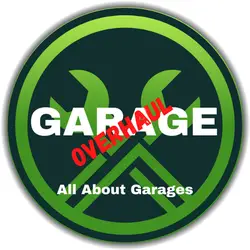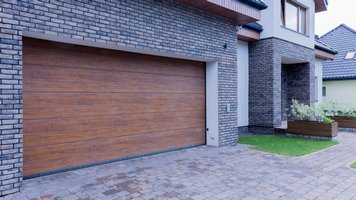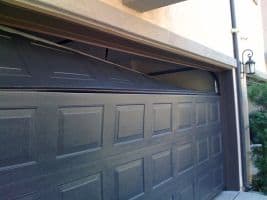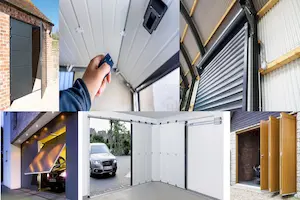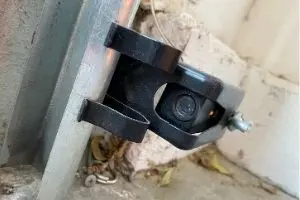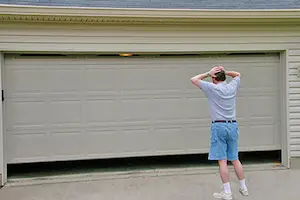Common Garage Door & Opener Problems (Troubleshooting & How to Fix)
This post contains affiliate links.
Do you have troubles with a garage door not closing or opening or some other problems with the garage door or opener? There are many reasons why this happens. Let’s troubleshoot and fix the reasons.
What to Do When the Garage Door Won’t Close
If you are in a hurry, you can force the door to close by constantly pushing the wall button. And then using the emergency release cord that separates the garage door opener from the door. This way, you can close or open the door manually and investigate the problem later.
Close the Door
- The door must be closed before you pull the emergency release cord. Disengaging the door in up position can be dangerous, and the door could come crashing down. IF the springs are broken or poorly adjusted.
The Door Is Stuck
- IF the door is stuck in an open position, check that nothing is blocking the sensors. Or if the sensors are misaligned or dirty.
- You can also force the door to close by constantly pushing the opener button located inside the garage.
Pull the Emergency Release Cord
- This is a red rope that hangs from the door trolley. Pull it, and it disconnects the trolley from the opener. Now you can manually open or close the garage door.
Re-Connecting the Trolley
- Align the trolley and garage door arm. You can use a remote or if the power is out, operate the door manually.
- Pull the emergency release cord down and toward the door. You should hear a loud click. In some models, you have to pull the trolley towards the opener.
Reasons Why Garage Door Won’t Close
The most common reasons for the door not to close are:
- Dirty or misaligned sensors.
- Obstruction in the tracks and rollers.
- Wrong opener limits and force settings.
The wiring may be damaged and needs to be inspected from sensors to the opener and the wall unit.
Misaligned or dirty sensors are by far the most common reason why garage doors won’t open or close properly.
Why Is the Garage Door Not Working?
There is a problem with some of the components that make the door go up or down. It can be:
- Logic board
- Sensors
- Wires
- Gears
- Motor
- Emergency release
- Springs
- Cables
- Rollers
- Tracks
- Openers limits and force is adjusted wrong
Garage Door Opener Logic Board
Openers have a logic board that makes the whole system work. It’s a circuit board inside the garage door opener unit. Sometimes they break and need to be replaced.
How to Fix Garage Door Opener Logic Boards
- You can swap the main circuit board or just change the entire assembly. The assembly holds the power board and mainboard. Check the model and manufacturer from the unit. You need to know them when purchasing a new unit.
- The capacitor inside the unit might be broken too.
If you’re interested in changing the circuit board yourself. you can find them on Amazon.
You can reset logic boards by unplugging the opener for one to two minutes.
Garage Door Sensors
Garage opener sensors are a safety feature for the garage doors, so they don’t close onto somebody or something. Sensors are often misaligned because of their location. Something might hit them, or the garage door’s mechanic force going up and down might lose the wingnut and cause the misalignment.
- Sensors also have to be cleaned regularly in dirty or dusty environments.
- Direct sunlight to the sensor eye might also be the cause why sensors don’t operate properly.
How to Fix Garage Door Sensors
- Make sure nothing is blocking the sensors.
- Clean the sensors
- Check the censors are not loose or misaligned.
- Sensor lights are on when they are working correctly. If lights are off, they are out of alignment, or something is blocking the infrared beam.
- If everything else is ok, then check the wires going to the sensors and, lastly, the opener itself.
Read all about garage door sensors here.
Garage Door Opener Wires
Wires run from sensors to the garage door opener and button on the garage’s wall, which operates the garage door. Wires can be damaged by mechanical force. Wires should never be stapled down with too small staples. That will damage the cables. When you test the wires in the staples, the wires should move freely.
Different critters can eat wires, like mice.
- Check also where the wires go in the unit. Make sure every wire is secured correctly to the port assigned to them.
How to Fix Garage Door Opener Wires
If there is damage to wires, they need to be replaced entirely, or you can take the damaged section out and connect the wires again when done correctly. But the wiring is cheap and damaged wires can be a fire hazard.
Garage Door Opener Gears
Openers have gears that are sometimes made from plastic and will wear down and need to be replaced. If your garage door opener is a chain drive model. Make sure the chain is not too tight, or it might break the gear.
How to Fix Garage Door Opener Gears
- Open the case and see if plastic particles are inside or the tooths are worn out.
- Gears might be worn out. They can make grinding or buzzing sounds. Check the gears.
If you’re interested in changing the gears yourself. You can find them on Amazon.
Read how garage door openers work in here.
Creative ways to Repurpose old openers.
Garage Door Opener Motor
The opener electric motor might fail suddenly or if the garage door springs are broken or not correctly adjusted. Then the electric motor will wear out sooner than later because of the extra stress.
- The motor might also be overheating from constantly repeated usage. Let it cool for 15-30 minutes.
- The Motor Rpm sensor might be broken. It can be replaced.
The motor might be failing if:
- The garage door opener vibrates
- The opener is making lots of noise
- The door moves sluggish or slow
- The door won’t open.
How to Fix Garage Door Motor
It’s usually best to change the whole opener unit to a new one.
Garage Door Emergency Release
All garage door openers have an emergency release function. When you pull the red cord, the garage door opener is separated from the garage door, so the door can be operated manually. You have to connect the door back to the opener for regular operation.
Check the door is not disconnected from the opener trolley. Pull the red cord down and towards the door or opener. You should hear a loud click.
How to Use Garage Door Emergency Release
Close the Door
- The door must be closed before you pull the emergency release cord. Disengaging the door in up position can be dangerous, and the door could come crashing down. IF the springs are broken or poorly adjusted.
Pull the Emergency Release Cord
- This is a red rope that hangs from the door trolley. Pull it, and it disconnects the trolley from the opener. Now you can manually open or close the garage door.
Re-Connecting the Trolley
- Align the trolley and garage door arm. You can use a remote or if the power is out, operate the door manually.
- Pull the emergency release cord down and toward the door. You should hear a loud click. In some models, you have to pull the trolley towards the opener.
Garage Door Springs
Garage door springs offset the weight of the door. A problem with the spring tension could cause the door to open or close unevenly, improperly, or at the wrong speed.
Check Springs
- Close the door and pull the emergency release cord.
- Try to lift the door. It should be easy to operate. The door should stop in place and not close or open when you are not touching it.
How to Fix Garage Door Springs
- Extension springs can be replaced DIY easily.
- Torsion springs can be dangerous without proper tools and should be left to the experts.
- A gap in the torsion spring means the spring is broken.
Read more about garage doors springs in here.
Garage Door Cables
- Cables run both sides of the door, from drums at the top to the door’s bottom.
- Springs turn the pulley that pulls the cables.
- Check the cables are not broken or loose.
How to Fix Cables
Fixing or replacing cables is best left to the professionals.
Garage Door Rollers
Rollers are on both sides of the garage door itself. They keep the door traveling in the tracks properly.
How to Fix Garage Door Rollers
- Rollers should be loose and able to move.
- Rollers should be a little bit loose in the track, so they don’t get pinched when the door travels up or down. Sometimes plastic rollers just break and need to be replaced.
If you’re interested in changing the rollers yourself. You can find them on Amazon.
Read all about garage doors in here.
Read more about garage maintenance here.
Garage Door Tracks
Door tracks guide the door when it’s traveling up and down.
How to Fix Garage Door Tracks
- Check the tracks for scratch marks. The garage door rollers might hit some screws.
- Tracks can be adjusted by loosening the screws.
- Tracks can be adjusted a bit, so rollers have space to work. Just open the screws, adjust the tracks and tighten the screws back again.
- Check also all the hardware that keeps the rollers and tracks in place that nothing is loose. Check the cables also and all the nuts and bolts.
Garage Door Opener Limits and force
The opener needs to be programmed during the installation. The opener needs to “know” when the garage door is all the way closed and all the way open. Or it just won’t work correctly. All openers have travel adjustments with buttons or with some common brands like chamberlain have two setscrews on the unit’s backside.
How to Adjust the Garage Door Opener Limits And Force
Always test the safety reversal system afterward when adjusting limits and force.
Testing the Safety Reversal Systems on Garage Door
Garage Door Opener Buttons
There might be two or more buttons depending on the manufacturer and model. There can be only one button that acts as a reset and a learn button.
Some models have adjustment buttons for the door travel and position. There can also be screwdriver-operated turnable knobs for door position and travel.
Buttons can have texts like learn or home. Buttons are usually located in the same place as the device antenna and next to a led light. Led colors range by model and brand. Depending on the model, you may need to remove an access panel.
Reset Button
There is usually a reset button in the garage door opener, used to reset the error codes and reset the remote codes.
How to Reset
Hold the button for 5-6 seconds, and the LED light should go on and then off. After that, all the remote codes should be erased. In some models, you have to push the button again quickly after the light goes off. Check the manufacturer instructions if necessary.
Learn Button
This is used to program the remote.
Open the opener cover and locate the button and push it. LED light should turn on. Push the remote button. The door opener light should flash. Now the opener works with your remote.
Garage Door Opener Lights and Sounds
Door openers have flashing lights and sound to inform you that something is wrong.
Lights
Chamberlain & Craftsman
| Code | Condition | Advice |
|---|---|---|
| 1 Flash | Sensors are completely misaligned or sensor wires are broken | Realign the safety reversing sensors so that the LED on the receiving sensor glows steadily. Reconnect any loose wires between the safety reversing sensors and the logic board. Replace the safety reversing sensor wires if damaged. |
| 2 Flashes | Safety reversing sensor wires are shorted or the safety reversing sensor wires are reversed on the logic board | Repair or replace any damaged wires between the logic board and the safety reversing sensors. Connect the safety reversing sensor wires on the logic board following the guidelines in your owner’s manual. |
| 3 Flashes | Wall mounted door control wires are shorted | Repair or replace any damaged wires between the logic board and the wall-mounted door control. |
| 4 Flashes | Safety reversing sensors are slightly misaligned | Realign the safety reversing sensors so that the LED on the receiving sensor glows steadily. |
| 5 Flashes | Motor overheated | The motor can overheat if the door is opened and closed several times in a row. Unplug the garage door opener to reset the logic board. Allow the motor to cool for about 15 minutes before restoring power and using the garage door opener. Pull the emergency door release and check the up-and-down travel of the garage door for binding. Repair the garage door if it doesn’t travel smoothly. If it overheats after a single use and the garage door travel is smooth, replace the motor. |
| 6 Flashes | Motor circuit failure | Replace the logic board. |
| Rapid Flashing | Signal is being received from a compatible remote transmitter | The logic board is receiving the signal from a compatible remote transmitter. Program the remote transmitter device to link to the logic board. Follow the instructions in your owner’s manual to program the remote. |
Genie
| Code_____________ | Condition | Advice |
|---|---|---|
| Red LED blinks once, pauses and repeats | A remote device transmitter has not been programmed | Program the remote device following the instructions in your owner’s manual. |
| Green LED blinks once, pauses and repeats | Obstruction between the sensors, door is binding or door travel limit needs programming | Remove any obstruction between the safety reversing sensors. Pull the emergency door release and check the up-and-down travel of the garage door for binding. Repair the garage door if it doesn’t travel smoothly. Program the door travel limits following the instructions in the owner’s manual. |
| Green LED blinks twice, pauses and repeats | Continuous obstruction between the sensors, sensors are out of alignment, bad wiring connections on the power head, or door travel limit needs programming | Remove any obstruction between the safety reversing sensors. Realign the safety reversing sensors if askew. Unplug the garage door opener and reconnect any loose wires on the power head. Program the door travel limits following the instructions in the owner’s manual. |
| Green LED blinks 3 times, pauses and repeats | Travel limits are backwards | Clear and reprogram the travel limits following the instructions in your owner’s manual. |
| Green LED blinks 4 times, pauses and repeats | The wall control wires are reversed on the power head or the wall control wires are shorted | Reverse the wall control wires on the power head if improperly connected. Unplug the garage door opener and replace the wires for the wall control if damaged. If the wires are okay, replace the wall control. |
| Green LED blinks 5 times, pauses and repeats | Chain/belt is too tight or control system failure | Adjust the chain/belt tension following the instructions in your owner’s manual. If the chain/belt tension is okay, replace the control board assembly. |
Liftmaster
Here is a link to Liftmaster diagnostic codes
Raynor
Here is a link to Raynor diagnostic codes
Guardian
Here is a link to Guardian diagnostic codes
Hormann
Here is a link to Hormann diagnostic codes
Linear
Here is a link to Linear diagnostic codes
Marantec
Here is a link to Marantec diagnostic codes
Overhead Door
Here is a link to Overhead Door diagnostic codes
Sommer
Here is a link to Sommer diagnostic codes
Check out garage door opener manufacturers here.
Garage Door Opener Sounds
Beeps
- The opener can beep if the sensors are not aligned. When the opener is operating with battery power, it will beep.
- If the opener beeps every 30 seconds, it’s running low on battery power and unable to recharge. You might need to replace the backup battery.
- Openers can have timers to close the garage door, and when it’s about to close the garage door, it beeps to let you know.
- If your opener has MyQ tech and someone is about to close the garage door from a remote location. It will beep to warn anyone in the vicinity. It’s a safety feature.
- Constant beeping indicates the door is closing unattended.
- 1 beep means the garage door opener is placed into limit and force Learn mode.
Clicks
- The garage door opener can make clicking noises as a result of the security lock.
- A faulty circuit board can cause the garage door opener to make clicking Sounds.
- Clicking sounds from the garage door opener may also be caused by issues with the sensors.
Humming Sound
- The door lock may be activated.
- Check the door is connected to the opener.
- The capacitor may need replacing.
- The motor is damaged.
- The logic board is broken.
- The trolley might be stuck. Inspect that it hasn’t run to a bolt and get stuck or some other obstacle.
- Check the door is on the tracks properly.
- Check the tracks and rollers are obstruction-free.
- Check the springs aren’t broken.
- Test the door manually that it is balanced correctly.
Garage Door Opener LED Lights
Led lights are not recommended to be used in garage door openers because they can cause issues. This is because of the frequencies the door openers use. The door opener frequencies go up to 360mhz, and most LED light bulbs are only made to work up to 300Mhz.
It’s recommended to use an incandescent light bulb or fluorescent light. Incandescent works best.
They also sell special LED bulbs(paid link) that can be used with garage door openers.
Garage Door Opener Battery
Some openers have battery backup. The battery can be replaced. The batteries are designed to run 20 complete open and close cycles, equating to about 1-3 days of regular operation.
The backup battery is an accessory and has a one-year warranty from the date of purchase.
Changing the Garage Door Opener Battery
- Disconnect the opener power cord.
- Open the light cover and remove the battery cover
- Pull the battery out
- Disconnect the battery wires
- Install new battery at opposite order.
If you’re interested in changing the backup battery yourself. You can find them on Amazon.
Always call the experts to inspect and fix the garage door and opener problems if you doubt you can fix the issues yourself. Fixing something the wrong way will cost more money, time and might be dangerous. There are many dangerous parts in the garage doors and openers.
Troubleshooting Garage Doors & Openers
Why Won’t the Garage Door Open?
- Check rollers and tracks that there are no obstructions.
- Springs may be broken or need to be adjusted.
- Gears may be broken.
- The cables might be broken.
- There is something wrong with the opener. Check the wires and logic board and power board. There might also be a bad capacitor inside the unit.
- Check the remote batteries and external keypad batteries.
- Opener limits and force need to be adjusted.
- Check the rollers and tracks for frozen water.
- The door bottom weather seal might be frozen to the ground. Gently tap the bottom of the door with a piece of wood.
Why My Garage Door Won’t Close All the Way?
- Sensors have dirt or are misaligned.
- Check also rollers and tracks.
- Springs may need to be adjusted.
- Opener limits and force need to be adjusted.
- Check the power board and the mainboard inside the unit.
Why Won’t the Garage Door Open All the Way?
- Check rollers and tracks.
- Springs may need to be adjusted.
- Opener limits and force need to be adjusted.
- There might be a bad capacitor inside the unit.
- Check the power board and the mainboard inside the unit.
The Garage Door Will Not Close but Will Open
- Sensors have dirt or are misaligned.
- Springs may need to be adjusted.
- Check the tracks and rollers.
- Opener limits and force need to be adjusted.
Why the Garage Door Stops Halfway?
- Sensors have dirt or are misaligned.
- Springs may need to be adjusted.
- Opener limits and force need to be adjusted.
- There might be a bad capacitor inside the unit.
- Check the power board and the mainboard inside the unit.
The Garage Door Opens Too Far
- Opener limits and force need to be adjusted.
Why Won’t the Garage Door Stay Closed?
- Check any obstructions in the ground under the door.
- Sensors have dirt or are misaligned.
- Opener limits and force need to be adjusted.
- Springs may need to be adjusted.
- Check the cables.
- Check the logic and power boards inside the opener.
- Check the rollers and tracks and lubricate if necessary.
Garage Door Won’t Close in Sunlight
Direct sunlight sometimes obstructs the sensors. You can block the sun shining directly to the sensor with some cardboard or something similar and duct tape. Just don’t block the sensor eye.
Why Does the Garage Door Opens by Itself?
- Check remotes, wall buttons, and panels. So everything works, and buttons don’t stick.
- Faulty wires can short together and trigger the motor unit to open or close the door. A defective wall control can cause the same problem. Check the wiring between the motor unit and the wall control panel.
- The logic or power board inside the opener might be failing.
- There might be a bad capacitor inside the unit.
- Sensors might be broken, dusty, or misaligned.
- For some older models of garage openers, radio frequency interference might be the culprit. If your opener is that old. It’s time to replace it with a modern, safer opener.
The Garage Door Opens by Itself After Closing
- Check any obstructions in the ground under the door.
- Sensors have dirt or are misaligned.
- Opener limits and force need to be adjusted.
- Springs may need to be adjusted.
- Check the cables.
- Check the logic and power boards inside the opener.
- Check the rollers and tracks and lubricate if necessary.
Garage Door Won’t Close Intermittently
- Springs may need to be adjusted.
- Check the rollers and tracks that there is space for rollers to operate correctly.
- Check the sensors for dirt and misalignment.
- When the garage door opener works intermittently, the logic board may be experiencing radio frequency (RF) interference from nearby sources. Such as security lights, ham radios, and some electronics. If the remote works only when held within a few feet of the motor unit, RF interference is probably the problem. Locate and eliminate the source of the RF interference. To determine the source, disconnect electrical power to suspected sources, one by one.
Why Does My Garage Door Not Close Smoothly?
- Springs may need to be adjusted.
- Check the rollers and tracks that there is space for rollers to operate correctly.
- Remove dirt from tracks and rollers and lubricate them.
- Go over all the hardware and nuts and bolts and tighten them if necessary.
Why Would a Garage Door Randomly Open?
- Check remotes, wall buttons, and panels. So anything works, and buttons don’t stick.
- Faulty wires can short together and trigger the motor unit to open or close the door. A defective wall control can cause the same problem. Check the wiring between the motor unit and the wall control panel.
- The logic or power board inside the opener might be failing.
- There might be a bad capacitor inside the unit.
- Sensors might be broken, dusty, or misaligned.
- For some older models of garage openers, radio frequency interference might be the culprit. If your opener is that old. It’s time to replace it with a modern, safer opener.
Why the Garage Door Won’t Open in Cold Weather
- Check the remote batteries and external keypad batteries.
- Check the rollers and tracks for ice and snow.
- The door bottom weather seal might be frozen to the ground. Gently tap the bottom of the door with a piece of wood.
- The opener force needs to be adjusted.
- There might be a bad capacitor inside the unit. Check the power board and the mainboard inside the unit.
- Grease and lubricants coagulate in freezing weather and can affect opener and tracks and rollers’ operation.
- Metal also contracts in cold weather and can make the door and tracks and rollers contracted and obstruct regular operation.
- The garage door springs might have broken in very cold.
Garage Door Not Working When Hot
- The opener might overheat. Let it cool for 15-30 minutes.
- Lubricate the tracks and rollers.
- The opener force needs to be adjusted.
- There might be a bad capacitor inside the unit. Check the power board and the mainboard inside the unit.
- Humidity makes wooden doors swell.
Garage Door Won’t Close Evenly
- Check the spring system. Especially extension springs can make the door not close evenly.
- Check also the tracks and rollers work freely.
- Check the cables.
The Garage Door Won’t Close Just Beeps
There is an obstruction somewhere, so the door doesn’t close fully. The sounds and flashes are a notification feature in some garage door openers.
- Sensors aren’t aligned
- The opener is operating with battery power
The garage door opener can signal an error code by flashing lights on the motor unit repeatedly when the opener doesn’t work. Check the sounds and lights section of the article.
The Garage Door Won’t Close Just Clicks
The sounds and flashes are a notification feature in some garage door openers.
- The garage door opener can make clicking noises as a result of the security lock.
- A faulty circuit board can cause the garage door opener to make clicking sounds.
- Clicking sounds from the garage door opener may also be caused by issues with the sensors.
- Check the Rollers and tracks if the opener makes clicking noises.
- The garage door opener can signal an error code by flashing lights on the motor unit repeatedly when the opener doesn’t work. Check the sounds and lights section of the article.
Garage Door Remote Won’t Work
- First, change the remote batteries.
- Check if you are getting power to the opener. Try plug in something to the same outlet where the opener is connected.
- Check the circuit breakers, fuse, or GFCI outlet powering the door opener circuit. Reset the breakers or GFCI or fuses. Suppose the circuit breaker or GFCI is repeatedly tripping. In that case, it’s a sign that there is a short circuit somewhere in the system—possibly even the garage door opener. The motor might be burned out and needs to be replaced.
- The remote may need resetting. Check the buttons section of the article.
- Try to unplug the garage door opener and wait two minutes and plug it in again. This resets the logic board.
- Check if there is a light in the sensors or a wall button. Check the sensors for dirt and alignment too.
- Check your garage door opener is not lock in position in the wall switch.
- Try replacing the antenna wires or the whole logic board.
The Garage Door Won’t Close Just Humm
The sounds and flashes are a notification feature in some garage door openers.
- The door lock may be activated.
- Check the door is connected to the opener.
- A capacitor may need replacing.
- The motor is damaged.
- The logic board is broken.
- The trolley might be stuck. Inspect that it hasn’t run to a bolt and get stuck or some other obstacle.
- Check the door is on the tracks properly.
- Check the tracks and rollers are obstruction-free.
- Check the springs aren’t broken.
- Test the door is balanced correctly.
The garage door opener can signal an error code by flashing lights on the motor unit repeatedly when the opener doesn’t work. Check the lights and sounds section of the article.
How Do You Reset a Garage Door After a Power Outage?
- Check the circuit breakers, fuse, or GFCI outlet powering the door opener circuit. Reset the breakers or GFCI or fuses. Suppose the circuit breaker or GFCI is repeatedly tripping. In that case, it’s a sign that there is a short circuit somewhere in the system—possibly even the garage door opener. The motor might be burned out and needs to be replaced.
- Try disconnecting the opener. Wait for one to two minutes and plugging it on again.
- Sometimes you need to reset the codes between the opener and remote control. Check the buttons section of the article.
- If the motor doesn’t work, there might be something wrong with the unit. Check the power and mainboard inside the unit.
Resetting the Emergency Release
Close the Door
The door must be closed before you pull the emergency release cord. Disengaging the door in up position can be dangerous, and the door could come crashing down. IF the springs are broken or poorly adjusted.
Pull the Emergency Release Cord
This is a red rope that hangs from the door trolley. Pull it, and it disconnects the trolley from the opener. Now you can manually open or close the garage door.
Re-Connecting the Trolley
Align the trolley and garage door arm. You can use a remote or if the power is out, operate the door manually.
Pull the emergency release cord down and toward the door. You should hear a loud click. In some models, you have to pull the trolley towards the opener.
The Garage Door Won’t Close and the Light Blinks
- There is probably something blocking the sensors. Try to clean them first and check they are aligned.
- If the light in sensors is off or is flickering. The sensors are out of alignment and need to be adjusted.
- The lights are different with every manufacturer, but the lights need to glow evenly.
- There may also be a problem with the wires somewhere.
The garage door opener can signal an error code by flashing lights on the motor unit repeatedly when the opener doesn’t work.
Some garage door openers have error codes. Check the lights section of the article.
Why Garage Door won’t Close With Remote
- First, change the remote batteries.
- Check if you are getting power to the opener. Try plug in something to the same outlet where the opener is connected.
- Check the circuit breakers, fuse, or GFCI outlet powering the door opener circuit. Reset the breakers or GFCI or fuses. Suppose the circuit breaker or GFCI is repeatedly tripping. In that case, it’s a sign that there is a short circuit somewhere in the system—possibly even the garage door opener. The motor might be burned out and needs to be replaced.
- The remote may need resetting. Check the buttons section of the article.
- Try to unplug the garage door opener and wait two minutes and plug it in again. This resets the logic board.
- Check if there is a light in the sensors or a wall button. Check the sensors for dirt and alignment too.
- Check your garage door opener is not lock in position in the wall switch.
- Try replacing the antenna wires and the logic board.
Garage Door Keypad Not Working
- Replace the batteries and program the keypad again if needed. Instructions are usually on the cover of the keypad.
- Usually, you have to push the opener to learn button and type in the new pin code in the keypad, and press enter.
- Try to unplug the garage door opener and wait two minutes and plug it in again. This resets the logic board.
- There might be frayed wires inside the keypad too. You can remove the covers and check the wires are connected.
- Check the buttons don’t stick when pressed. If they do, you need to clean the whole keypad thoroughly.
- Keypads are exposed outside to humidity, rain, snow, heat, dust, and other elements and don’t last forever. If the keypad is old, it might need replacing.
Garage Door Won’t Close and Sensors Are Aligned
- Opener limits and force need to be adjusted.
- The alignment might be slightly off and need to be precise. One of the lights could appear to be solid. Still, it might be barely flickering in reality, meaning the sensors are not making a good connection.
- Direct sunlight sometimes obstructs the sensors. You can block the sun shining directly to the sensor with some cardboard or something similar and duct tape. Just don’t block the sensor eye.
- Check the sensor wires for damage. The wiring may need replacing if it is stapled too hard to the wall. The wire needs to move freely in the staple.
- Sensors might be broken and need to be replaced.
Check if the garage door opener is blinking error code. Check the lights section of the article.
Why the Garage Door won’t Open Manually
First, disconnect the emergency release so the door can move in manual mode. Make sure the emergency release works as intended.
- The springs may be broken, and the door is cumbersome to open by hand. The springs need to be replaced or adjusted.
- The rollers are broken, or the rollers are pinched to the tracks.
- The tracks are bent, or there are obstructions in the tracks.
- The cables are broken or loose.
Garage Door Not Working After a Lightning
- Check the circuit breakers, fuse, or GFCI outlet powering the door opener circuit. Reset the breakers or GFCI or fuses. Suppose the circuit breaker or GFCI is repeatedly tripping. In that case, it’s a sign that there is a short circuit somewhere in the system—possibly even the garage door opener. The motor might be burned out and needs to be replaced.
- The garage door opener circuit board might be fried and needs to be replaced. Powerboard inside the casing might also be fried and needs to be replaced.
- The manufacturer info and model are in the casing.
- The capacitor inside the unit might be broken too.
Put the Door in Manual Mode if There Is No Power
Close the Door
- The door must be closed before you pull the emergency release cord. Disengaging the door in up position can be dangerous, and the door could come crashing down. IF the springs are broken or poorly adjusted.
Pull the Emergency Release Cord
- This is a red rope that hangs from the door trolley. Pull it, and it disconnects the trolley from the opener. Now you can manually open or close the garage door.
Re-Connecting the Trolley
- Align the trolley and garage door arm. You can use a remote or if the power is out, operate the door manually.
- Pull the emergency release cord down and toward the door. You should hear a loud click. In some models, you have to pull the trolley towards the opener.
The Garage Door Won’t Close Unless a Button Is Held
- Check the wall panel that the lock button is off. There should be a led light indicator for the lock-out button.
- Something is blocking the sensors. Clean and adjust the sensors.
- Direct sunlight sometimes obstructs the sensors. You can block the sun shining directly to the sensor with some cardboard or something similar and duct tape. Just don’t block the sensor eye.
- Try to unplug the garage door opener and wait two minutes and plug it in again. This resets the logic board.
- Opener limits and force need to be adjusted.
- Check the sensor’s wires for damage. The wiring may need replacing if it is stapled too hard to the wall. The wire needs to move freely in the staple.
- Sensors might be broken and need to be replaced.
- Check the tracks and rollers works, and there are no obstructions.
- Try operating the door manually. Close the door and disconnect the opener with emergency door release.
The Garage Door Opens by Itself After a Power Outage
- Try to unplug the garage door opener and wait two minutes and plug it in again. This resets the logic board.
- There might be a bad capacitor inside the unit.
- Check the power board and the mainboard inside the unit.
- Faulty wires can short together and trigger the motor unit to open or close the door. A defective wall control can cause the same problem. Check the wiring between the motor unit and the wall control panel.
Garage Door Won’t Close After a Power Outage
- Check the circuit breakers, fuse, or GFCI outlet powering the door opener circuit. Reset the breakers or GFCI or fuses. Suppose the circuit breaker or GFCI is repeatedly tripping. In that case, it’s a sign that there is a short circuit somewhere in the system—possibly even the garage door opener. The motor might be burned out and needs to be replaced.
- Try disconnecting the opener. Wait for one to two minutes and plugging it on again.
- Sometimes you need to reset the codes between the opener and remote control. Check the buttons section of the article.
- If the motor doesn’t work, there might be something wrong with the unit. Check the power and mainboard inside the unit.
Garage Door Not Closing or Opening but Motor Running
- Check that the door is not in manual mode. Re-connect the door with the emergency release if necessary.
- Check no door locks are engaged.
- Garage door opener gears are worn out or broken.
- The belt or chain might be broken and need to be replaced.
- Something is obstructing the door. Check the rollers and tracks. Adjust if necessary.
- Check the springs aren’t broken.
- Check the cables aren’t broken or loose.
- Opener limits need to be adjusted.
- Close the door and use the emergency release.
- Check the door is closing and opening correctly manually.
Garage Door Not Working After Pulling Red Cord
The red cord is an emergency release feature. When you pull the red cord, the garage door opener is separated from the garage door, so the door can be operated manually. You have to connect the door back to the opener for regular operation.
Resetting the Emergency Release
Close the Door
- The door must be closed before you pull the emergency release cord. Disengaging the door in up position can be dangerous, and the door could come crashing down. IF the springs are broken or poorly adjusted.
Pull the Emergency Release Cord
- This is a red rope that hangs from the door trolley. Pull it, and it disconnects the trolley from the opener. Now you can manually open or close the garage door.
Re-Connecting the Trolley
- Align the trolley and garage door arm. You can use a remote or if the power is out, operate the door manually.
- Pull the emergency release cord down and toward the door. You should hear a loud click. In some models, you have to pull the trolley towards the opener.
Garage Door Is Making a Lot of Noise
- If you have a chain drive. Check the chain is not too loose. Tighten the chain if necessary.
- If you have a belt drive. Check the belt is not too loose. Tighten the belt if necessary.
- If you have a screw drive. Lubricate the screw regularly.
- Go over all rollers, tracks, and any hardware and tighten any loose nuts and bolts.
- Gears might be worn out. They can make grinding or buzzing sounds. Check the gears.
- The Motor unit might be worn out and needs to be replaced.
- Balance the springs.
- Nylon rollers are quieter than steel rollers. Consider changing them.
- Install noise insulator pads made from rubber between the ceiling and opener.
Lubricate the rollers, tracks, springs, gears, chain drive, and screw drive regularly. Use lithium-based grease.
Always call the experts to inspect and fix the garage door and opener problems if you doubt you can fix the issues yourself. Fixing something the wrong way will cost more money, time and might be dangerous. There are many dangerous parts in the garage doors and openers.
